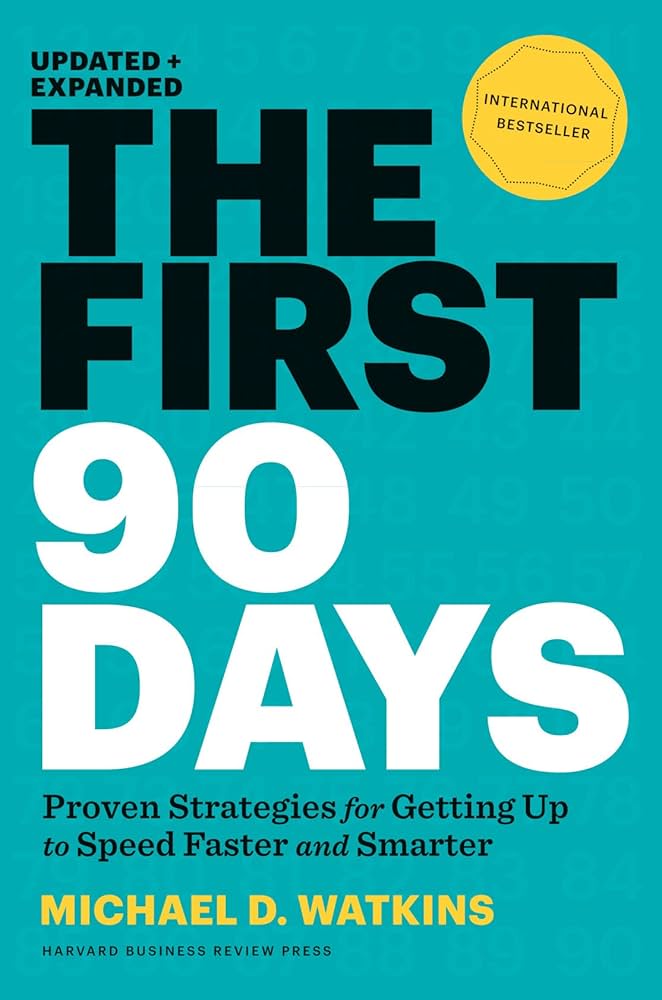In the ever-shifting landscape of professional life, the ability to navigate change is both a crucial skill and a formidable challenge. Michael D. Watkins, in his seminal work “The First 90 Days,” serves as a guiding compass for leaders stepping into new roles or facing transformative transitions. drawing on rich insights and actionable strategies, Watkins illuminates the intricate dance of adaptation, urging readers to embrace the pivotal window of the first three months as a period ripe with prospect for impact and growth. in this review, we will delve into the essential lessons gleaned from Watkins’ expertise, exploring how they resonate within the broader context of leadership and change management.
Understanding the Framework of Transition in the First 90 Days
Transition,notably in the early stages of a new role,harnesses the delicate balance between opportunity and uncertainty.The framework outlined in ‘The First 90 Days’ serves as a vital roadmap for navigating this transformative period. Watkins emphasizes key strategies that are essential to bolster competencies and align with organizational goals. Leaders are encouraged to:
- Assess the Situation: Understand the dynamics at play through thorough analysis.
- Secure Early Wins: Identify manageable projects that deliver immediate results to build momentum.
- Build Relationships: Foster connections with stakeholders to enhance collaboration and support.
- Align Goals: Ensure that personal objectives align with the larger vision of the organization.
To harness these strategies effectively, individuals must recognize the importance of actively engaging with their team and adapting to the company’s culture. One way to create a deeper understanding is through a structured approach, which can be visualized in the following table:
| Focus Area | actionable Steps | Expected Outcomes |
|---|---|---|
| Leadership Style | Solicit feedback from team members | Improved trust and collaboration |
| Team Dynamics | Hold regular check-ins and updates | Increased clarity and cohesiveness |
| Strategic Planning | Define short and long-term objectives | Clear direction and measurable success |
Key Strategies for Executives to Initiate Successful Leadership Change
For executives embarking on leadership changes, it’s crucial to establish a clear and purposeful vision. This involves communicating objectives effectively to align the team with the new direction. Executives can adopt the following strategies:
- Engage Stakeholders: Involve key players early in the transition to build trust and gain valuable insights.
- Assess Current Capabilities: Evaluate team strengths and weaknesses to strategize effectively.
- Set Immediate Goals: Define short-term achievements that will demonstrate progress and mitigate resistance.
- Foster Open Dialog: Encourage feedback to cultivate an atmosphere of transparency and collaboration.
Building momentum during periods of change requires a thoughtful approach to team dynamics. Consider implementing a structured plan that includes regular check-ins and performance evaluations. Below is a simple outlining of potential milestones:
| Milestone | Timeline | Responsible Party |
|---|---|---|
| Team Alignment Meeting | Week 1 | executive Team |
| Skill Assessment Workshops | Weeks 2-4 | HR Department |
| quarterly Review of objectives | End of Quarter 1 | Department Heads |
By focusing on clear communication, strategic planning, and accountability, executives can effectively steer their organizations through leadership changes and foster a resilient work surroundings.
The importance of Building Relationships and Trust within New Teams

In the chaotic whirlwind of new team dynamics, the bedrock of success is frequently enough laid down through well-crafted relationships and the cultivation of trust. When team members feel connected, communication channels open up wider, collaboration becomes more seamless, and innovation flourishes. Establishing rapport is not merely about personal chemistry; it’s an essential strategy for enhancing team adaptability. By prioritizing interpersonal connections, newcomers in a leadership position can foster an environment that encourages feedback, creativity, and mutual respect.
The journey towards building this foundation can be navigated with a few essential practices:
- Active Listening: Demonstrating genuine interest in team members’ ideas and challenges breeds confidence.
- Consistency: Reliability in actions and decisions reinforces trust and signals to the team that their leader is dependable.
- transparency: Sharing information openly cultivates a culture of honesty, making team members feel valued and included.
Implementing these strategies not only strengthens relationships but also creates a resilient team capable of tackling challenges head-on. Engaging with your team within the first critical weeks sets the tone for a culture of trust that can carry forward into future endeavors.
Assessing the Organizational Landscape for Smooth Transitions
Understanding the organizational landscape is crucial for leaders embarking on new roles, especially during times of transition. A comprehensive assessment allows one to identify the key players, cultural dynamics, and operational structures that define the environment. Here are some essential considerations to keep in mind:
- Influential Stakeholders: Recognize who holds power and sway within the organization.
- Organizational Culture: Gauge the prevailing norms, values, and shared beliefs that shape behaviors.
- Structural Framework: Map out the hierarchy and communication channels to understand decision-making processes.
Additionally, leveraging a structured approach can enhance understanding and facilitate smooth navigation through change. Utilizing a SWOT analysis can be particularly effective for this purpose, providing a holistic view of strengths, weaknesses, opportunities, and threats. Below is a simple depiction of how this framework can be applied:
| SWOT Category | Examples |
|---|---|
| Strengths | Established brand reputation, skilled workforce |
| Weaknesses | Outdated technology, departmental silos |
| Opportunities | Market expansion, new product lines |
| Threats | Economic downturn, increased competition |
Prioritizing Quick Wins: Establishing Momentum Early in Leadership

In the early stages of leadership, seizing quick wins can substantially bolster your credibility and energize your team. These are not just minor victories; they serve as pivotal moments that create a ripple affect throughout your organization. By identifying a few manageable, yet impactful, objectives, you can showcase your ability to drive change effectively. For example, consider focusing on initiatives such as:
- Enhancing team communication through more frequent check-ins or updates.
- Streamlining existing processes for efficiency, making day-to-day tasks easier for your team.
- Celebrating small successes to foster a sense of achievement and motivation.
Achieving these quick wins enables you to build momentum, establish trust, and lay the foundation for more considerable changes ahead.As your team starts to experience the benefits of these initiatives, you can leverage this momentum to tackle larger strategic goals. Constructing a simple table can help prioritize these objectives and demonstrate their impact, as shown below:
| Quick Win | expected Impact | Timeframe |
|---|---|---|
| Enhance team communication | improved collaboration | 1 month |
| Streamline processes | Increased efficiency | 2 months |
| Celebrate small successes | Higher morale | Ongoing |
The Role of Learning Agility in Adapting to New Challenges

In today’s fast-paced world, the ability to learn quickly and adapt is crucial for success, especially when faced with new challenges. Learning agility empowers individuals to embrace change by applying past experiences to current situations and refining their approaches based on feedback. As emphasized in Michael D. Watkins’ insights, the initial steps taken during transitional periods shape the trajectory of one’s leadership effectiveness. Those who exhibit learning agility can swiftly analyze the landscape, recognize patterns, and make informed decisions that foster resilience and innovation.
Organizations thriving in dynamic environments often cultivate a culture that celebrates learning agility. By encouraging a growth mindset, they enable employees to take calculated risks and explore uncharted territories. Effective strategies to enhance learning agility include:
- Seeking Diverse Perspectives: Engage with different teams to gain insights.
- Continuous Feedback: Establish channels for constructive criticism and learning.
- Reflective Practices: Regularly assess past actions and their outcomes.
By integrating these practices, teams become equipped to tackle unexpected challenges and seize opportunities that arise from change.
Navigating Organizational culture: Aligning with Existing Norms
Understanding and integrating into the organizational culture is pivotal for anyone looking to make a critically important impact within their new role. Every organization has its unique set of values, beliefs, and behaviors that shape the workplace dynamics.To ensure a successful transition, it is essential to:
- Observe and Listen: Spend time understanding the day-to-day operations and the unwritten rules that influence decision-making.
- Engage Key Stakeholders: Build relationships with influential team members who can offer insights into the cultural fabric of the organization.
- Assess Alignment: Reflect on how your own values align with those of the organization, identifying areas for potential growth.
Once you have a grasp of the existing norms, the next step is to navigate them with intention. Adjust your communication style and approach based on the prevailing culture to foster acceptance and trust. Consider creating a strategy matrix to map out key cultural elements against your objectives:
| Culture Element | Current State | Desired State |
|---|---|---|
| Decision-Making Process | Consensus-driven | More streamlined |
| Communication Style | Formal | More open and direct |
| Team Collaboration | Isolated units | Cross-functional synergy |
Effective Communication Techniques for Leaders during Transition
Transition periods can be tumultuous for any organization, making it vital for leaders to harness effective communication techniques that foster clarity and alignment. A leader’s ability to articulate a vision not only helps to reduce uncertainty but also empowers team members to embrace change. Consider employing the following strategies:
- Active Listening: engage with team members to understand their concerns and insights, creating an open feedback loop.
- Consistent Messaging: Ensure communication is frequent and consistent to minimize rumors and speculation.
- Empathy in Communication: Acknowledge the emotional aspects of change, reinforcing that everyone’s feelings are valid and crucial.
Additionally, implementing structured communication platforms can enhance the transition process. Whether through regular updates or team meetings, establishing a framework can make information dissemination smoother. Consider using this table to track key communication initiatives:
| Initiative | Description | Frequency |
|---|---|---|
| Weekly Team Check-ins | Open forums to discuss progress and concerns during the transition. | Every Friday |
| Monthly Updates | Overview of goals achieved and milestones ahead. | First Monday of each month |
| Feedback Surveys | Collect anonymous input to assess team morale and adapt strategies. | Every two weeks |
Creating a 90-Day Action Plan: A Blueprint for Success

Creating a successful 90-day action plan is akin to crafting a master blueprint. During this critical transition period, leaders should focus on gaining insight into their new environment while establishing their priorities and building essential relationships.Key elements to consider in your action plan include:
- Assessing Your Environment: Spend time understanding the organization’s culture, workflows, and the key players.
- Setting Clear Objectives: Define measurable goals that align with both personal aspirations and the organization’s vision.
- Building Relationships: Network with team members, stakeholders, and other influencers to foster collaboration and support.
- Identifying Quick Wins: Look for opportunities to initiate immediate, impactful changes that can build credibility.
To effectively monitor your progress, create a table that outlines your objectives alongside timelines and milestones, ensuring that you stay on track. Here’s a simplified template to guide your planning:
| Objectives | Timeline | Milestones |
|---|---|---|
| Complete stakeholder analysis | Week 1 | Identify key influencers |
| Define team goals | Week 3 | align with organizational objectives |
| Implement a feedback loop | Week 5 | Gather input from team |
| Achieve the first milestone | Month 3 | Review outcomes and adjust strategy |
Leveraging Feedback Loops to enhance Leadership effectiveness

Feedback loops serve as vital instruments in refining leadership practices and ensuring that leaders are adjusting effectively to their environments. When leaders actively solicit input from their teams, they make space for an open dialogue that can illuminate blind spots and unearth areas for advancement. This reciprocal exchange not only cultivates trust but also empowers team members, making them feel valued and heard. By implementing regular check-ins and creating structured opportunities for feedback, leaders can gain actionable insights that spark innovation and reinforce team cohesion.
Effective implementation of feedback mechanisms often involves establishing a consistent cadence and utilizing various tools to gather diverse perspectives. Consider incorporating the following practices to enhance your leadership journey:
- One-on-One Meetings: Personal engagements create a safe space for team members to express their views.
- 360-degree Reviews: Gathering feedback from multiple levels fosters a holistic understanding of performance.
- Anonymous Surveys: Allowing for anonymity can lead to more candid responses.
to transparently track and visualize feedback outcomes, leveraging a simple table can be effective:
| Feedback Source | Key Insights | Next Steps |
|---|---|---|
| Team Meeting | Need for clearer communication | Implement weekly updates |
| Anonymous Survey | Desire for more collaboration | Organize cross-functional workshops |
| One-on-One | concerns about workload | Assess task distribution |
The Significance of Self-Reflection in Leadership Development

Self-reflection is an essential component for effective leadership development, particularly in times of transition. When stepping into a new role, leaders face a myriad of challenges that require not just tactical expertise but also an understanding of their own strengths and weaknesses. This self-awareness enables leaders to:
- Align their leadership style with the organization’s culture.
- Identify blind spots that could impede progress.
- Develop emotional intelligence to foster stronger team dynamics.
By engaging in regular self-reflection, leaders can evaluate their experiences and decision-making processes, leading to more informed choices in the future. This practice encourages leaders to solicit feedback and adjust their approaches as necessary, creating a continuous cycle of improvement. Additionally, self-reflection helps leaders cultivate resilience, allowing them to adapt to uncertainties by reinforcing their purpose and vision.
| Self-Reflection Benefits | Impact on Leadership |
|---|---|
| Enhanced Decision-Making | More strategic outcomes. |
| Stronger Team Relationships | Increased trust and collaboration. |
| Resilience Development | Better handling of setbacks. |
Sustaining Change: Techniques for Long-Term Impact beyond 90 Days
To ensure long-term impact after the initial 90 days of change, leaders must implement strategies that foster sustainability and commitment within their teams. Cultivating a culture of continuous improvement is essential. this involves regularly seeking and acting on feedback, promoting open communication, and encouraging collaboration across all levels of the organization.Establishing mentorship programs can help in embedding these changes more deeply, as experienced members guide new arrivals, ensuring knowledge transfer and alignment with core values.
A structured approach to tracking progress is also pivotal. Utilizing key performance indicators (KPIs) allows teams to measure the efficacy of the changes made, promoting accountability and adaptability. Engage your team in regular review sessions to analyze progress and recalibrate strategies as needed.below is a simple table to illustrate potential KPIs to track for sustained impact:
| Metric | Description | Frequency |
|---|---|---|
| Employee Engagement | Measure team morale and buy-in | Quarterly |
| Productivity Rates | Analyze output against targets | Monthly |
| Customer Satisfaction | Gauge client happiness through surveys | Every six months |
The Contribution of Michael D. Watkins to Leadership Literature
Michael D. Watkins has made a significant impact on the realm of leadership literature through his groundbreaking work, particularly with his seminal book, *The First 90 Days*, which serves as a vital guide for leaders navigating transitions. His insights are not just theoretical; they are backed by extensive research and practical application, making them indispensable for anyone stepping into a new leadership role. watkins emphasizes the importance of understanding both the organizational culture and the political landscape, encouraging leaders to develop a roadmap for their initial months.Key contributions include:
- Transition Framework: Watkins introduces a structure for effectively managing transitions,drawing attention to the unique challenges of leadership roles.
- Strategies for Success: He provides actionable strategies that leaders can implement to accelerate their learning curve and solidify their influence.
- Personal Case Studies: By sharing real-world examples, Watkins illustrates how his principles can be applied in various contexts, enhancing relatability and comprehension.
Furthermore, watkins’ emphasis on the notion of the “learning curve” has reshaped how leaders approach their first three months in a new position. By categorizing transitions into five types – startup, turnaround, realignment, sustaining success, and tough situations – he allows leaders to tailor their strategies according to specific contexts. This nuanced understanding breaks down the transition process, empowering leaders to assess their situation critically and devise targeted plans. The following table succinctly outlines these transition types:
| Transition Type | Key Focus |
|---|---|
| Startup | establishing vision and team dynamics |
| Turnaround | Driving immediate change to reverse decline |
| Realignment | Shifting the organization towards strategic objectives |
| Sustaining Success | Maintaining momentum in a successful environment |
| Difficult Situations | navigating crises and restoring stability |
Key Takeaways
“Navigating Change: Insights from ‘The First 90 Days'” by michael D. Watkins stands as a beacon for those poised at the brink of transformation, whether in their careers or personal lives.This book distills critical strategies and frameworks that empower readers to not only survive but thrive amidst change. Watkins’ wisdom serves as a compass, guiding us through the often turbulent waters of new beginnings. As we wrap up our exploration of these insights, it’s clear that the principles laid out in this guide resonate far beyond a mere checklist for the first three months. They invite us to rethink the way we approach change—embracing it as an opportunity for growth rather than a hurdle to overcome. So, as you embark on your own journey, remember the lessons of adaptability, deliberate action, and thoughtful reflection that emanate from Watkins’ work. May they illuminate your path as you navigate whatever changes lie ahead.












